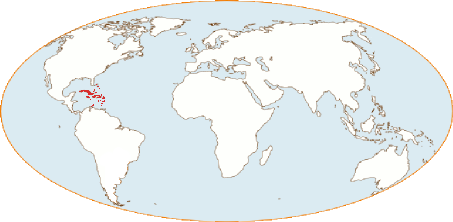Your search results [16 articles]
The religion of the Amerindians of the Caribbean.
The religion of the Amerindians of Martinique and Dominique[1], did not place man above Nature but among all living things. The world beyond is organised around two antagonistic powers. One, called Chemin, is a beneficial and protective spirit. Chemin makes nature bear fruit, protects and heals man, provided that he respects the beings (plants, animals, humans) that are in his power. The other, Mabouya, disturbs things and mistreats humans.
The ambivalence of these two powers, one face reversed from the other, is apparent in the mixture of veneration and fear that they inspire to the Amerindians. The description given by the Anonymous of Carpentras is both concise and clear[2]:
"Our Indians name the devil in two ways, namely Chemin and Mabouya. Chemin is the one, they say, who makes all their roots and fruits of the earth grow, who preserves them on the sea and keeps them from being taken by their enemies; who heals them when sick and who warns them of the ships and many other good beliefs they have in him.
Mabouya is the one who beats and torments them, who makes them be balibir, i.e. furious and demonic [under the influence of drunkenness in particular], and that after Chemin comes to heal them, because he makes them believe that it is not he who has thus beaten them, but that it is Mabouya or the Chemin[3] or one of their enemies and that he has come to heal them (because they believe that each one in particular, even the small leaves of trees, has its own particular Chemin which makes them grow), which is the main cause, for which they fear to displease one another, only to be beaten by Chemin of the one they have displeased. And however much they may have good faith in Chemin, yet they fear it more than they love it, as we have seen many times in their deeds and words, and how often they go away from a dwelling where they know that the said Chemin was there, or go there only reluctantly if they were forced to go in, and if he causes him the slightest displeasure, he threatens to have him beaten by the said Mabouya who is himself, and that afterwards He will not come to cure him, and is so well honoured that besides an infinity of superstitions." (Anonyme de Carpentras, 1618-1620, ed. Moreau 2002, 176-177).
[1] We restrict ourselves to the 2 islands described by the Anonymous of Carpentras.
[2] If we subtract from the text its use of the demonic to explain religious practices different from Catholic rites, an "interpretation" common in the 17th century or a way of writing to bypass the censorship imposed by the Church on everything that was published.The manuscript of the Anonymous of Carpentras remained locked up in a private library until its recent publication.
[3] The text here is unintelligible. Chemin refers both to a spirit, like Mabouya, and to a human intervener "who makes people believe", a kind of interpreter.J-P. Moreau, the editor of the text, noted the surprising absence of the Amerindian shaman whose importance in religious practices is noted in later chronicles, for example R. P. Jean de la Mousse, as early as 1684 (De la Mousse Jean 1684, Relation of the second voyage of Father Jean de la Mousse among the Indians of the Sinnamary River, the year 1684, Chandeigne ed. 2006). It is perhaps he who hides behind the double role played by "Chemin".



